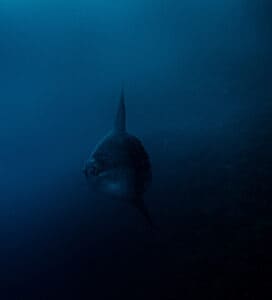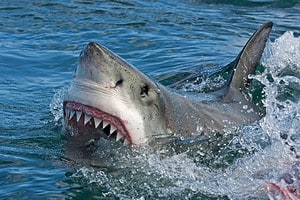The Gulf of Mexico is a popular spot for all kinds of fishing, and there are dozens of trophy fish available for the taking. Whether you’re looking for a tasty catch or a record-breaking creature, these 18 types of fish are some of the largest you can find in the Gulf of Mexico.
18. Gulf Flounder
Gulf flounder (Paralichthys albiguttata) are a species of flatfish. They swim on their side and have two eyes on the left side of their body which look up while they swim. Gulf flounder can often be found along the sandy bottom of the bodies of water they inhabit. They are olive-brown in color with blotches all over their body.
Gulf flounder have a distinctive appearance and are a popular gulf fish to eat. These saltwater creatures usually weigh under two pounds but may grow as large as six pounds.
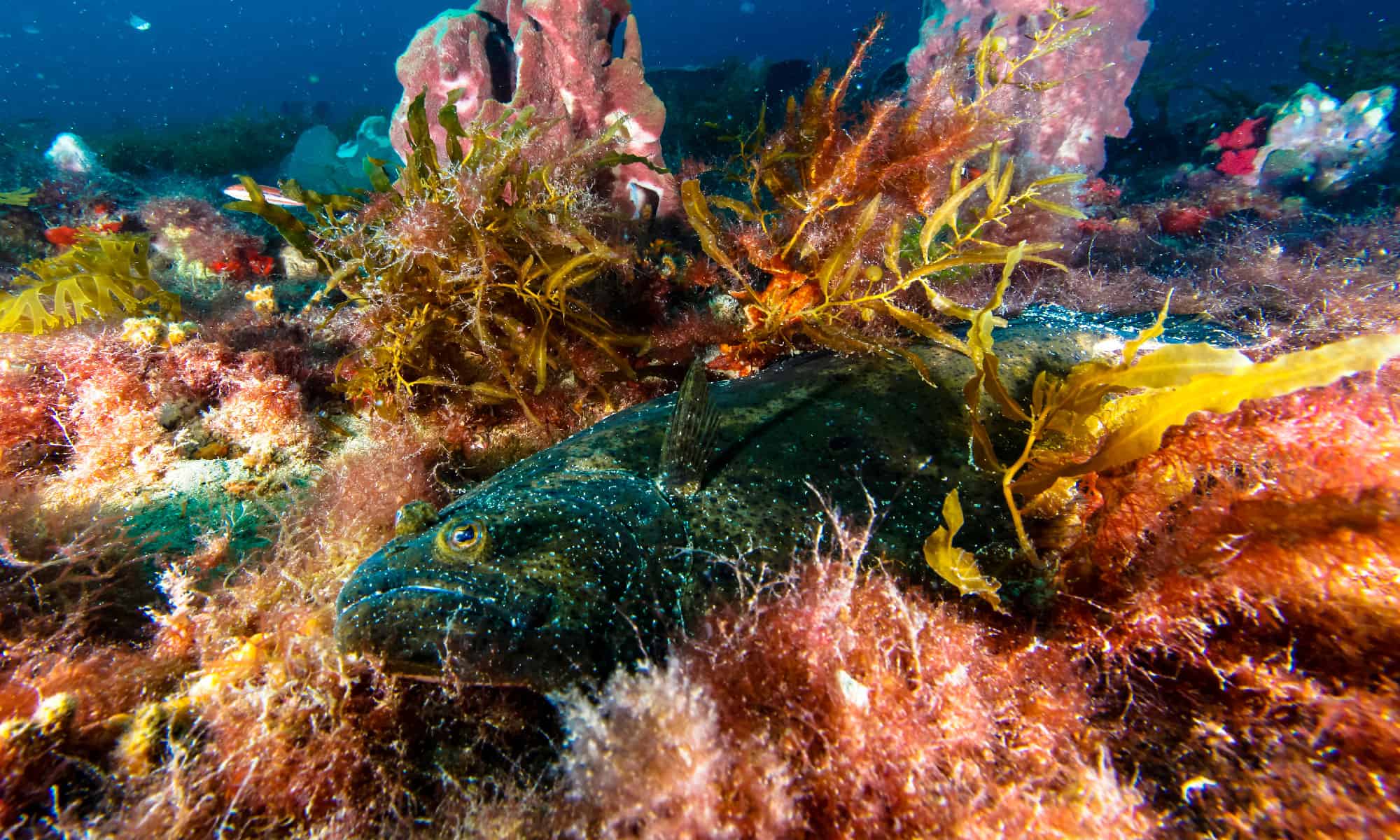
Gulf flounder have two eyes on the left side of their head.
©Porco_Rosso/Shutterstock.com
17. Florida Pompano
There are several different subspecies of pompano, and those found in the Gulf of Mexico appear to be a bit smaller than species in other parts of the world. The Florida pompano (Trachinotus carolinus) are typically 12-16 inches and 1-3 pounds, whereas species such as the African pompano can weigh as much as 50 pounds.
Still, that doesn’t mean the Florida pompano aren’t a valuable game fish. Florida pompano are abundant in Florida’s waters. They are also strong fighters and great-tasting fish. The largest recorded Florida pompano weighed 8 pounds, 4 ounces, according to the International Game Fish Association (IGFA).
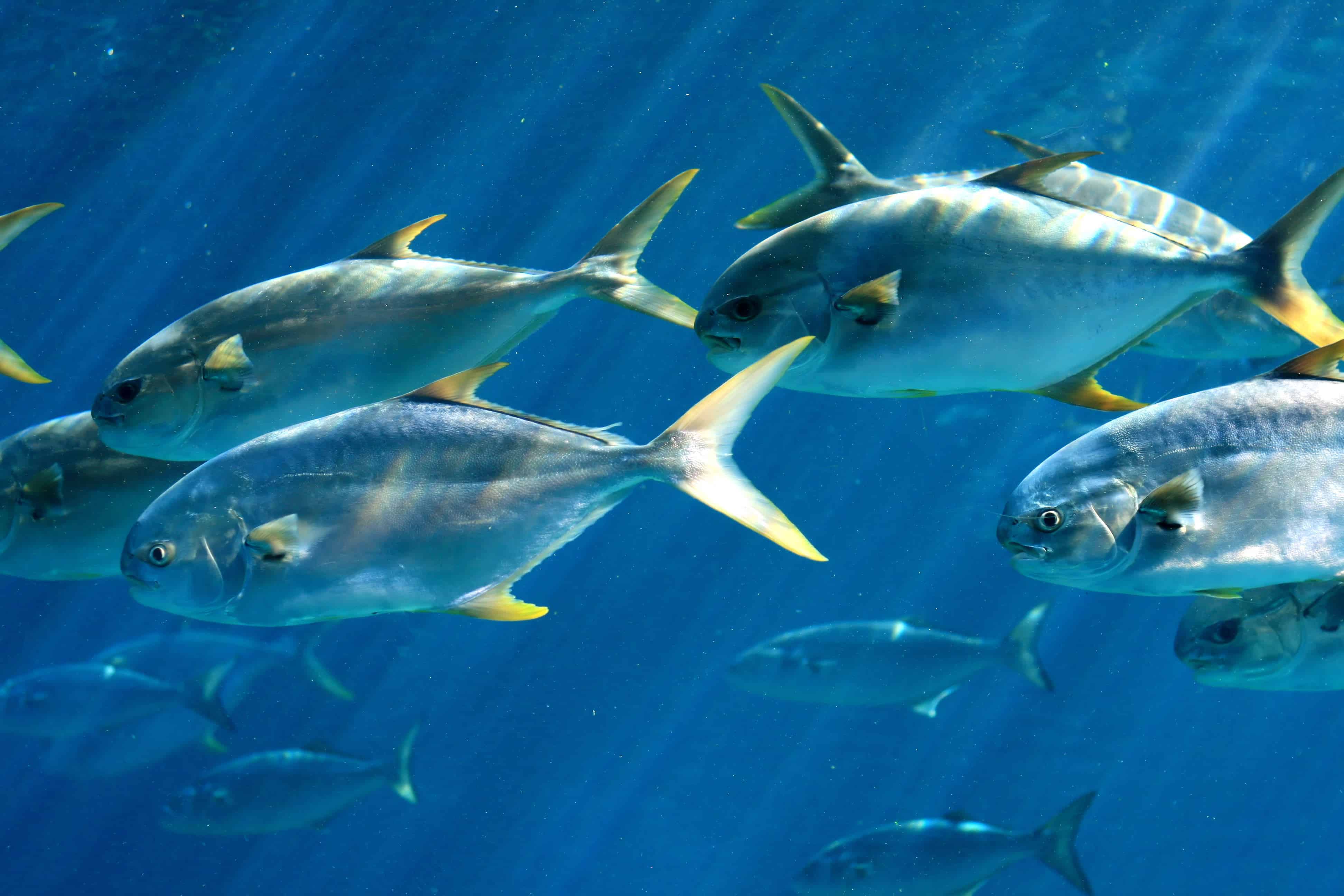
Pompano fish are abundant in Florida’s coastal waters.
©michaeljung/Shutterstock.com
16. Black Sea Bass
Black sea bass (Centropristis striata) make their home along the U.S. east coast. As their name suggests, they are black in color, though smaller varieties are more of a dusky brown. According to NOAA Fisheries, black sea bass are protogynous hermaphrodites, meaning that they generally start off as females and become males as they mature.
Black sea bass are slow-growing fish that typically weigh less than four pounds. The record catch of this species, caught in Virginia Beach, weighed 10 pounds, 4 ounces.
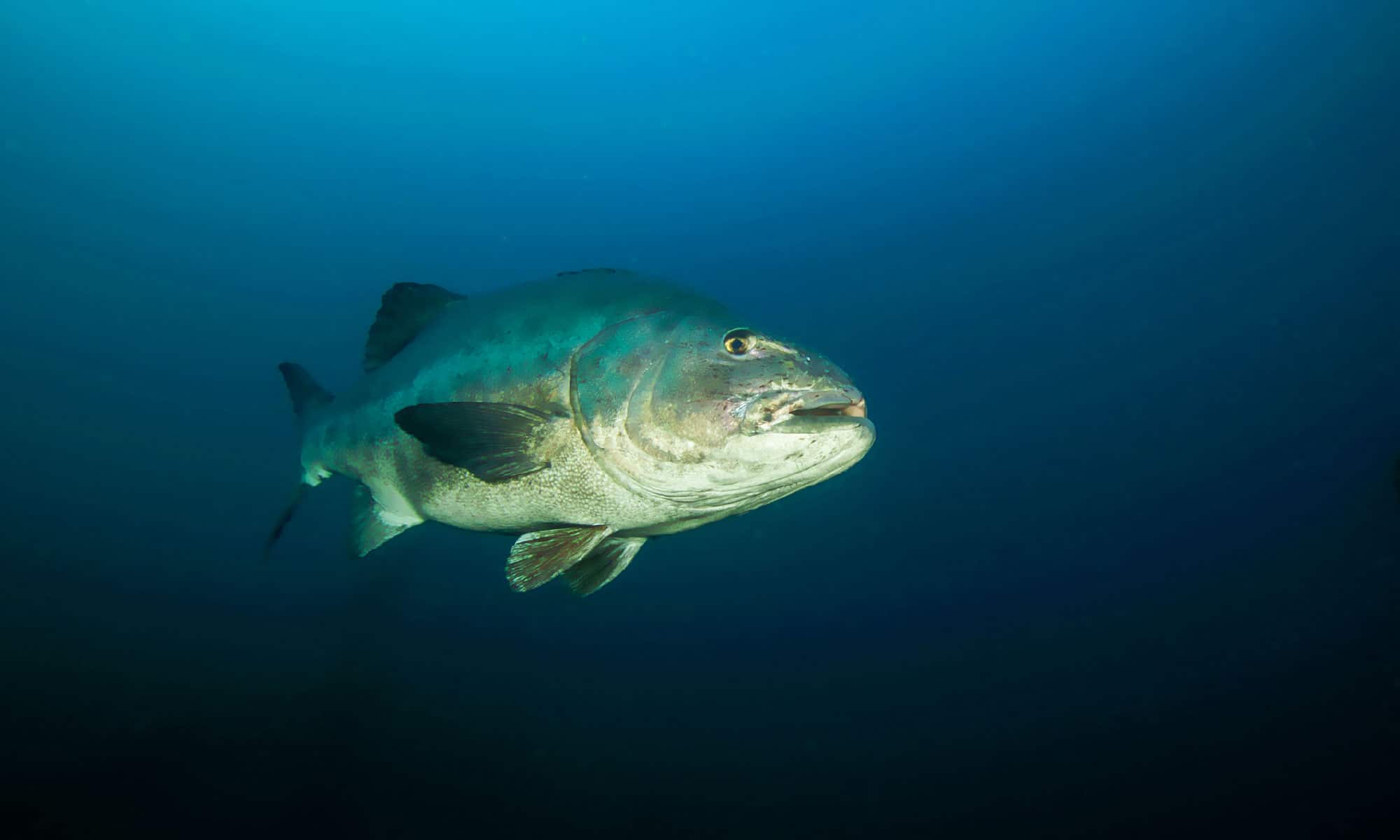
Black Sea Bass are hermaphroditic fish.
©iStock.com/KGrif
15. Spotted Sea Trout
Spotted sea trout (Cynoscion nebulosus), also known as speckled trout, are dark gray or green fish with black spots on their back, dorsal fin, and tail. Females are typically larger and spotted sea trout weighing around 5.5 pounds can be considered common. The largest spotted sea trout, which was caught near Fort Pierce, FL, weighed 17 pounds, 7 ounces.
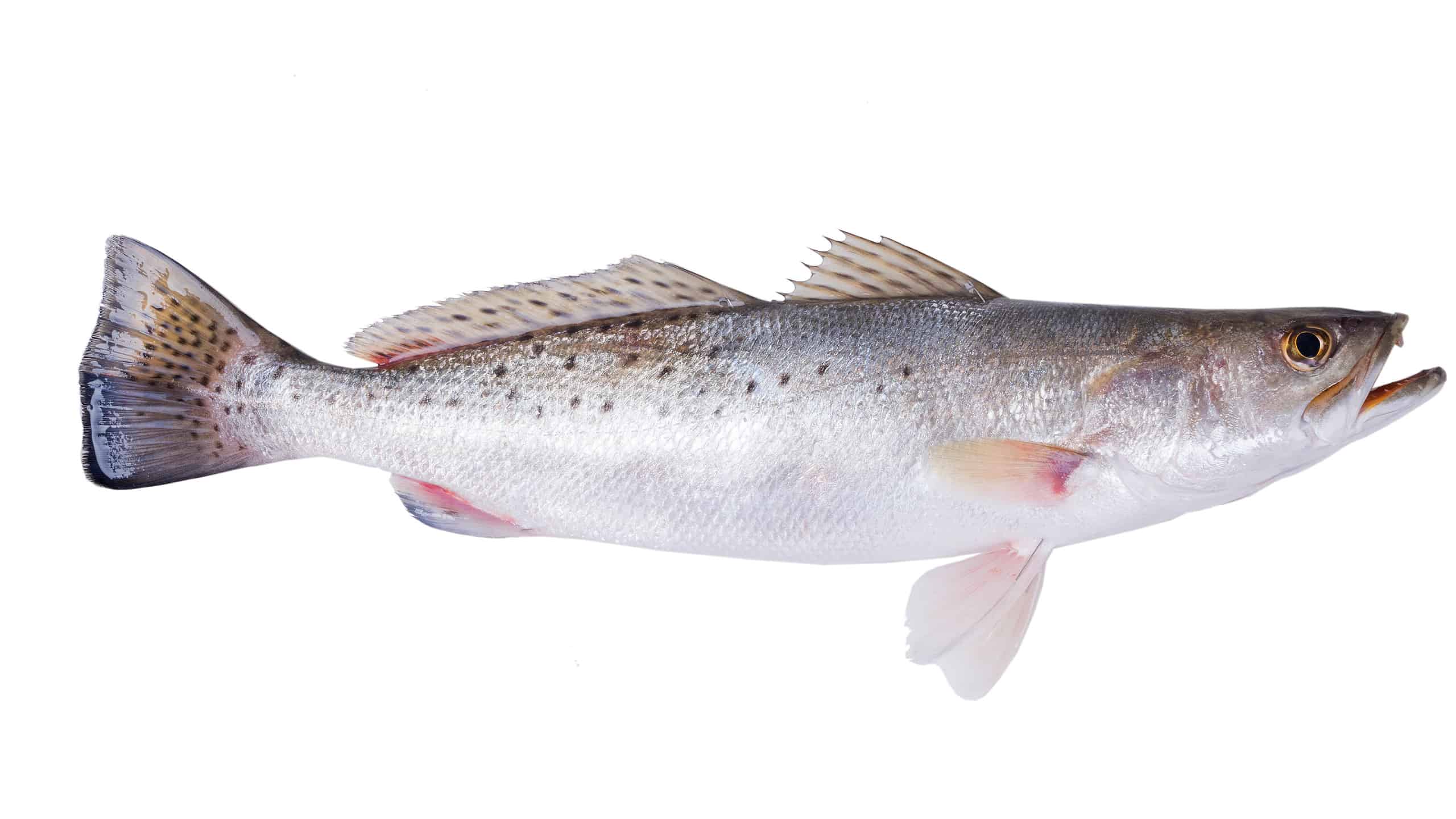
Spotted sea trout have black spots on their back, dorsal fin, and tail.
©IrinaK/Shutterstock.com
14. Sheepshead
Sheepshead fish (Archosargus probatocephalus) are as odd as they sound. These marine fish get their name from the shape of their mouth, which resembles the muzzle of a sheep, reports the BBC. Sheepshead also have several rows of teeth, with the front ones eerily resembling that of human teeth. They are usually gray in color with dark bars on their sides.
The greatest concentration of sheepshead is near southwest Florida. Sheepshead are a popular and tricky game fish, as they have a knack for stealing bait. The average sheepshead weighs 3-4 pounds and measures 13 inches in length, though the world record sheepshead catch tipped the scales at over 21 pounds.
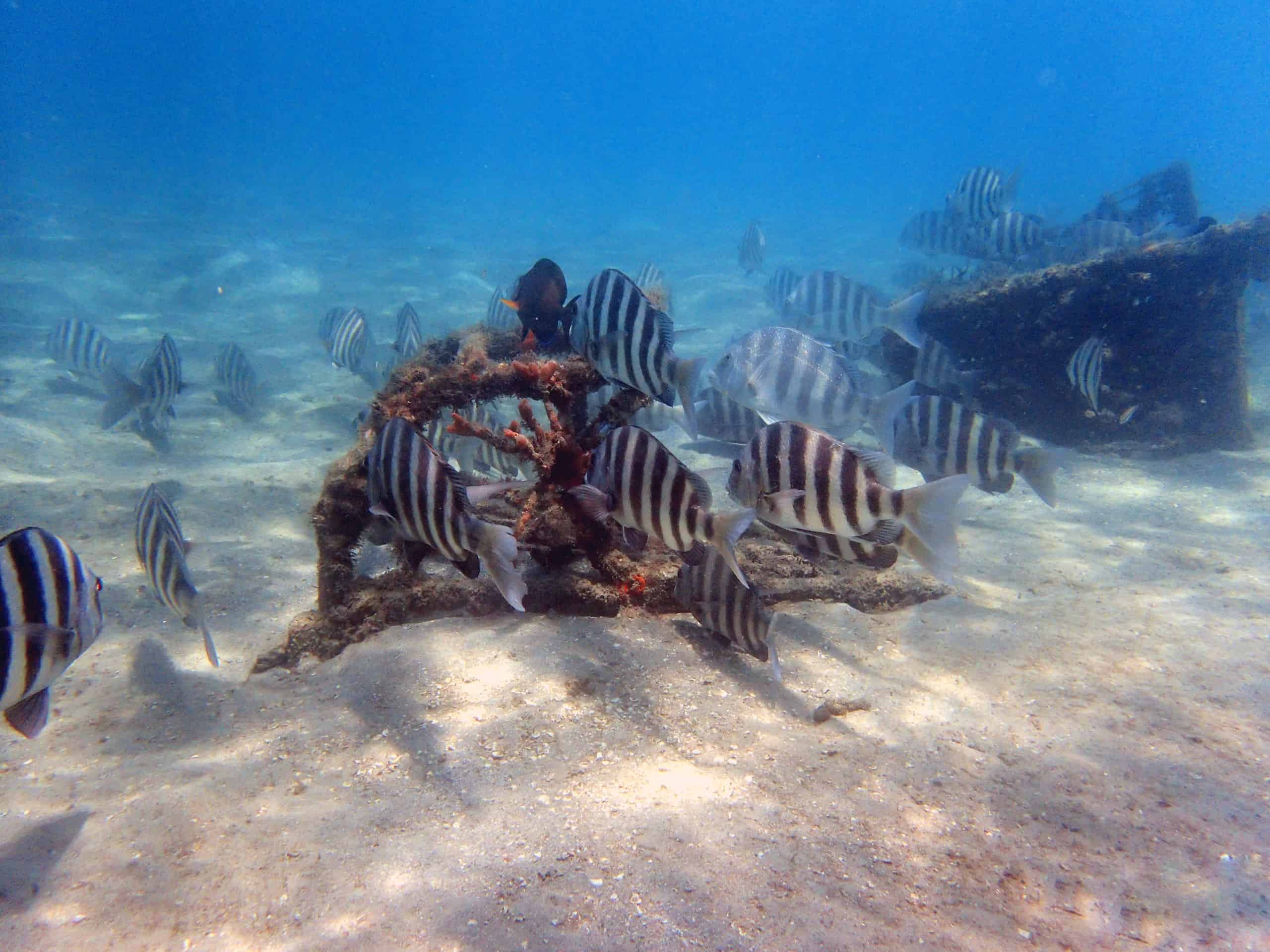
Sheepshead fish use their powerful teeth to open clams, mollusks, and other shellfish.
©Joni Hanebutt/Shutterstock.com
13. Bluefish
As their name suggests, bluefish (Pomatomus saltatrix) are primarily blue-green on their back with silvery sides and bellies. Some bluefish may only grow to lengths of around 7 inches. These smaller fish are known as “snappers.” The largest recorded bluefish weighed 31 pounds, 2 ounces, and NOAA estimates the max length of these species at 39 inches.
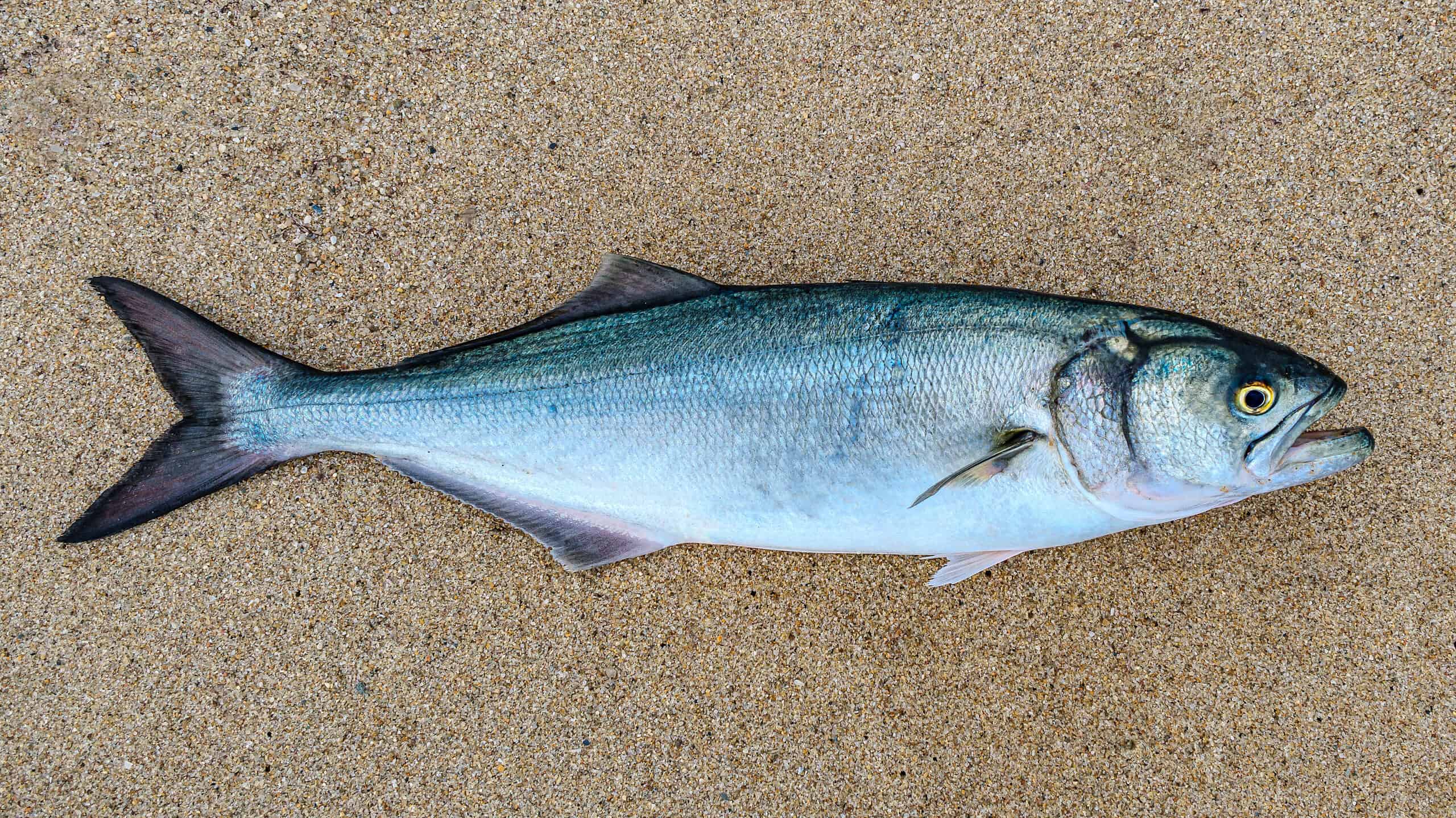
The bluefish is a blue-green shade.
©John Piekos/Shutterstock.com
12. Red Snapper
Red snapper (Lutjanus campechanus) get their name from their coloring and enlarged canine teeth. The deeper underwater these fish live, the more red in color they tend to be. Red snapper as old as 57 years have been reported to live in the Gulf of Mexico, according to NOAA.
The average red snapper is between 1-2 feet long and 2-4 pounds. Captain Doc Kennedy holds the current record for the largest red snapper caught in the Gulf of Mexico. The creature tipped the scales at 50 pounds, 4 ounces.
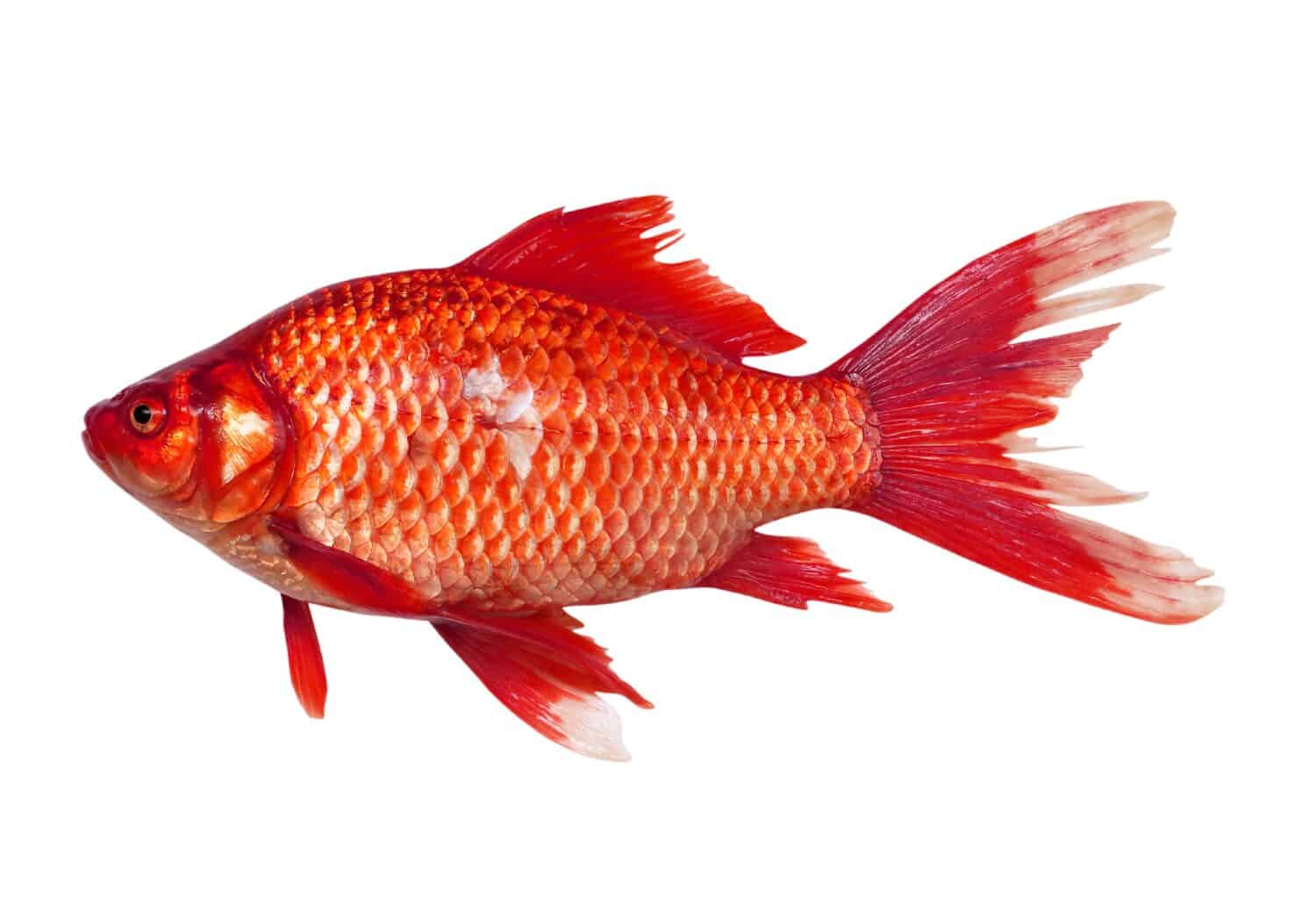
The red snapper is known for its distinctive red coloring.
©Abhishek Raviya/Shutterstock.com
11. Red Grouper
Red grouper (Epinephelus morio) are found in the Atlantic Ocean, from Massachusets through the Gulf of Mexico. They are common in shallow waters of 10-60 feet deep. As their name suggests, red grouper are dark reddish brown in color. Typically these fish weigh 5-10 pounds and do not measure over two feet long. However, the maximum recorded sizes for red grouper are 51 pounds and 49 inches long.
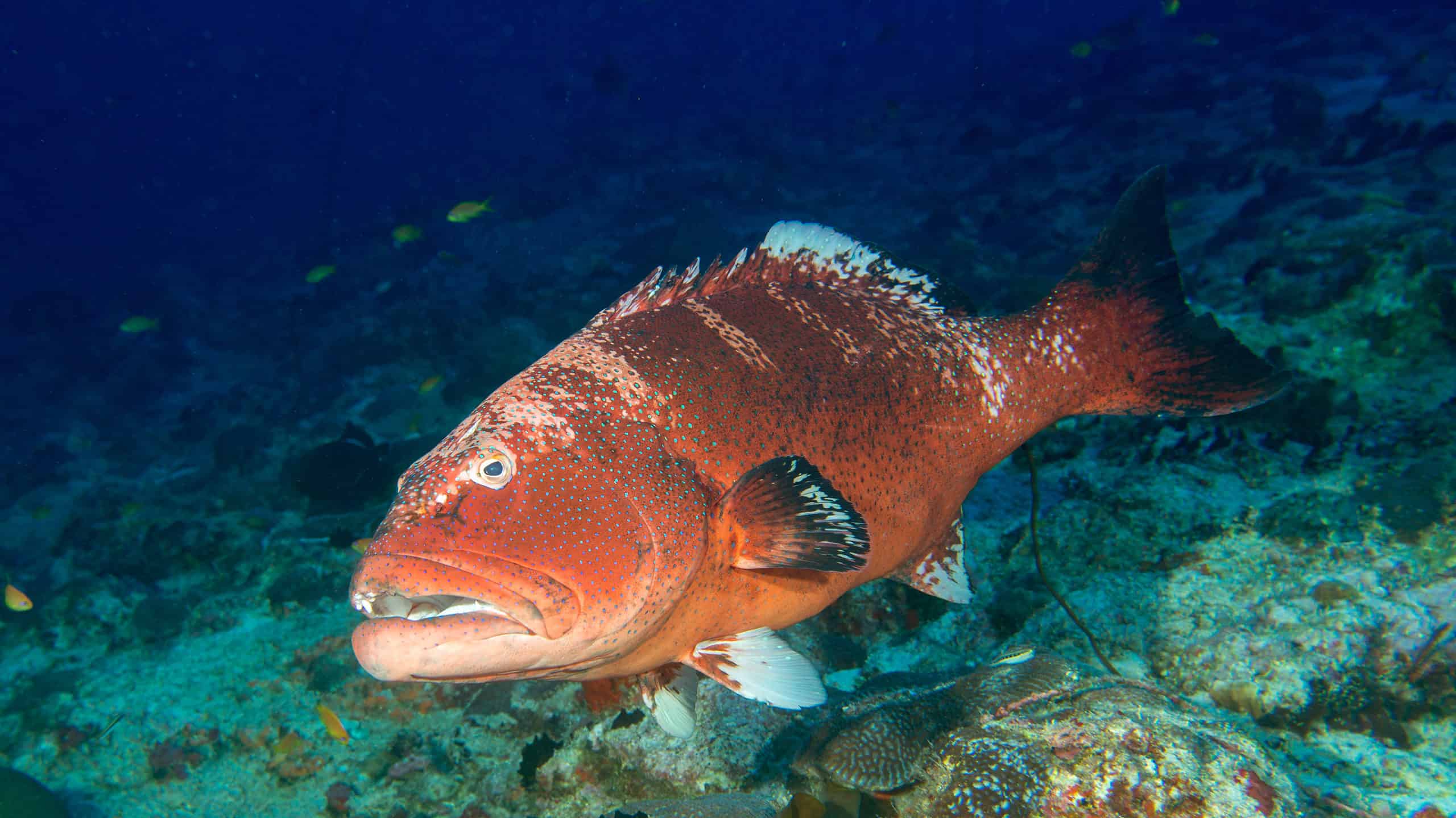
The largest red grouper weighed 51 pounds.
©Andrea Izzotti/Shutterstock.com
10. Crevalle Jack
Crevalle Jack (Caranx hippos) are common fish both inshore and in open waters, according to the Florida Fish and Wildlife Conservation Commission (FWC). They range in color from bluish-green to greenish-gold on their backs, fading to a silver or yellow-colored belly.
Crevalle Jacks weighing between 3-5 pounds are considered common, but Florida’s state record is a 57-pound creature caught near Jupiter, FL.
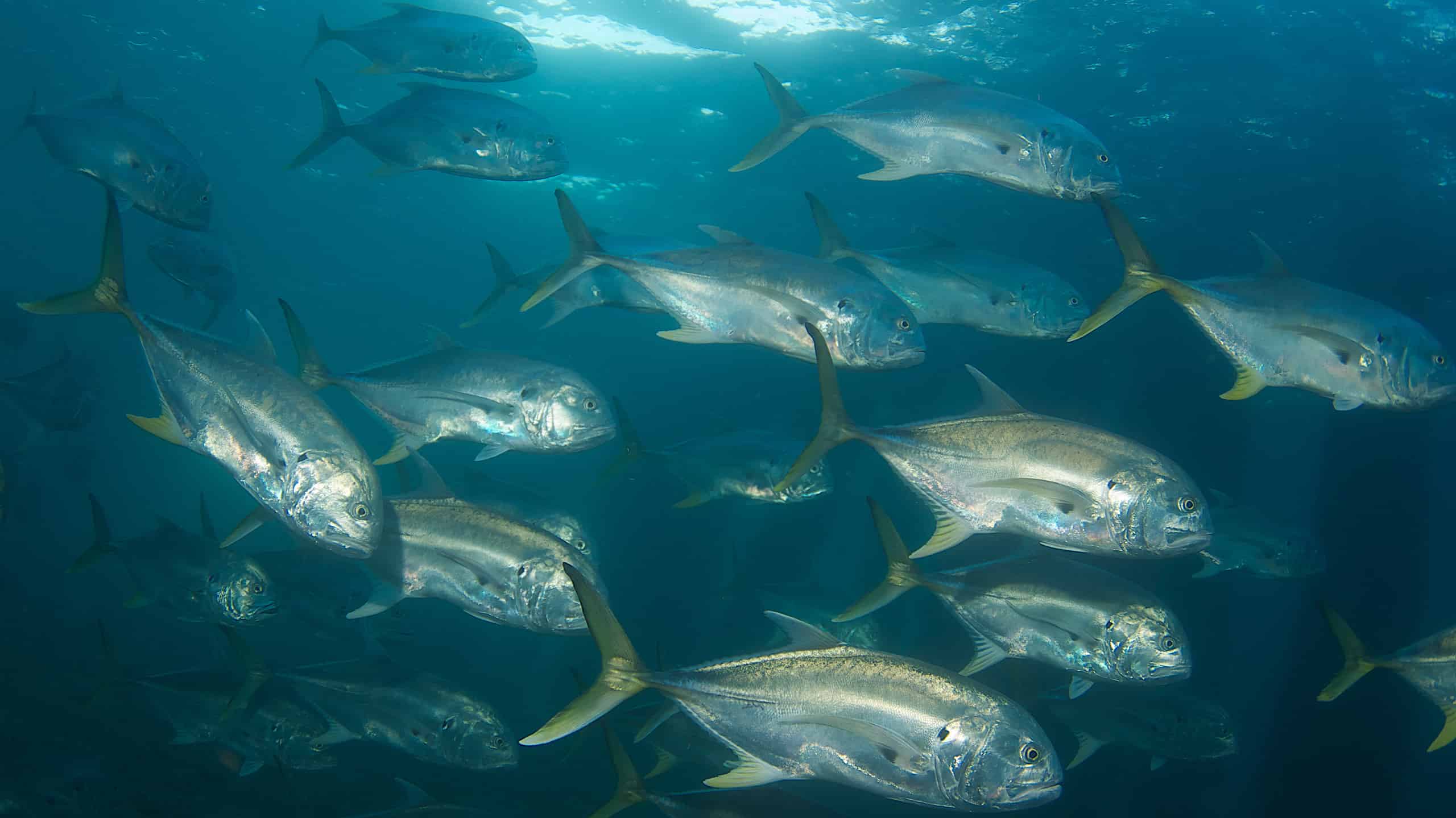
Although most adult crevalle Jack move in schools, some choose to go off on their own once they grow large enough.
©Jack Leahy/Shutterstock.com
9. Mahi-Mahi
Seafood connoisseurs have certainly heard of mahi-mahi (Coryphaena hippurus). These surface-dwelling fish are common near the Gulf of Mexico and are delicious, flaky, and tender when cooked. Mahi-mahi translates to “very strong” in the Hawaiian language.
They are highly sought after by fishermen due to their beautiful gold, bright blue, and green colors and value in the culinary world. Mahi-mahi can also grow to be quite large. While the most common catch ranges between 15-30 pounds, a mahi-mahi as large as 87 pounds was once caught off the coast of Costa Rica.
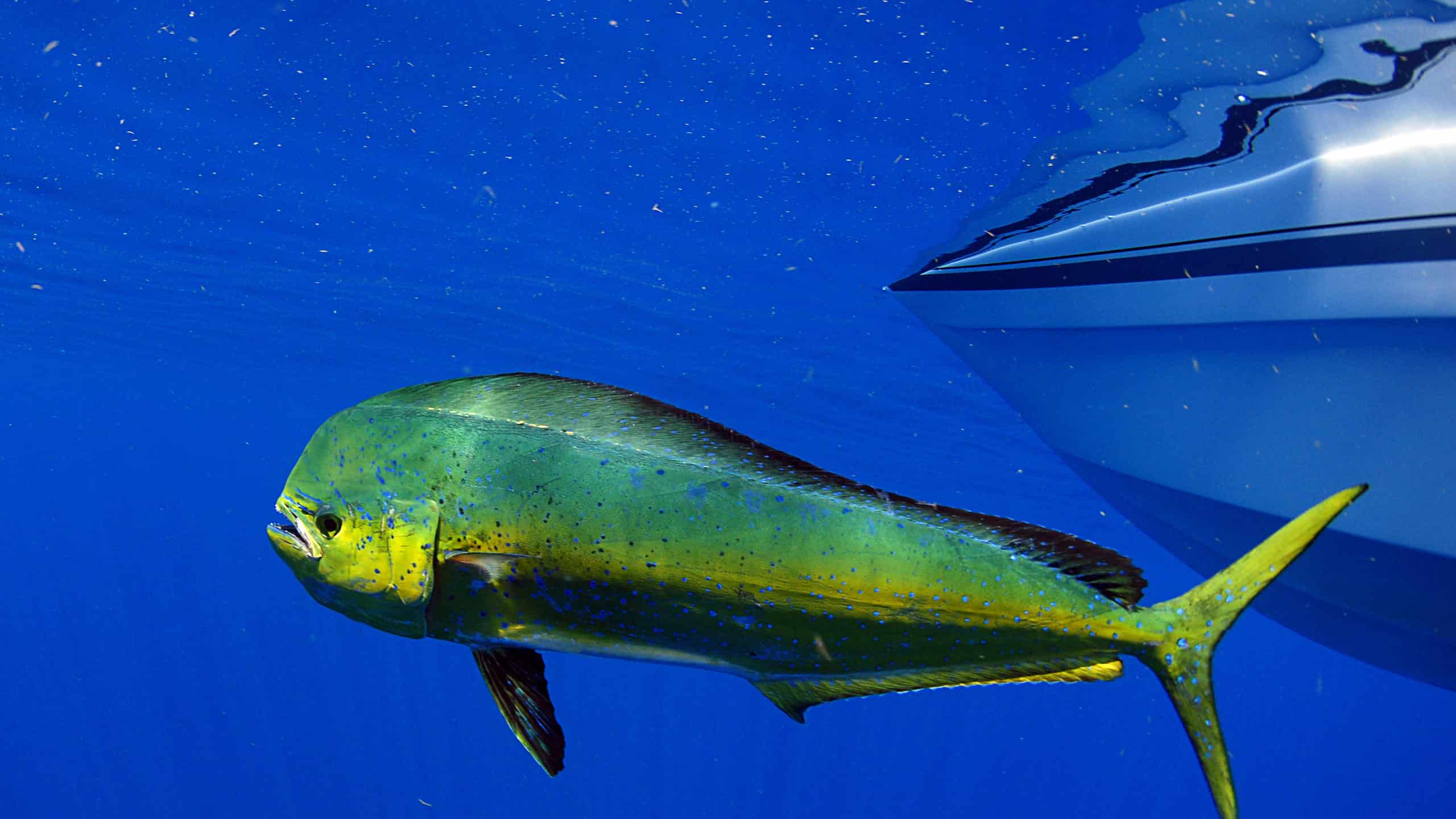
Mahi-mahi are known for their beautiful, bright colors.
©FtLaud/Shutterstock.com
8. Red Drum (Redfish)
Red drum (Sciaenops ocellatus), also known as redfish, get their name from their dark red color on top, which gradually fades toward the bottom of the fish. According to the FWC, the average red drum on the Gulf of Mexico coast is around 40 inches and 40 pounds.
Red drum are a popular Florida game fish due to their ability to fight for extended periods of time. The largest redfish ever caught weighed a whopping 94 pounds, 2 ounces.
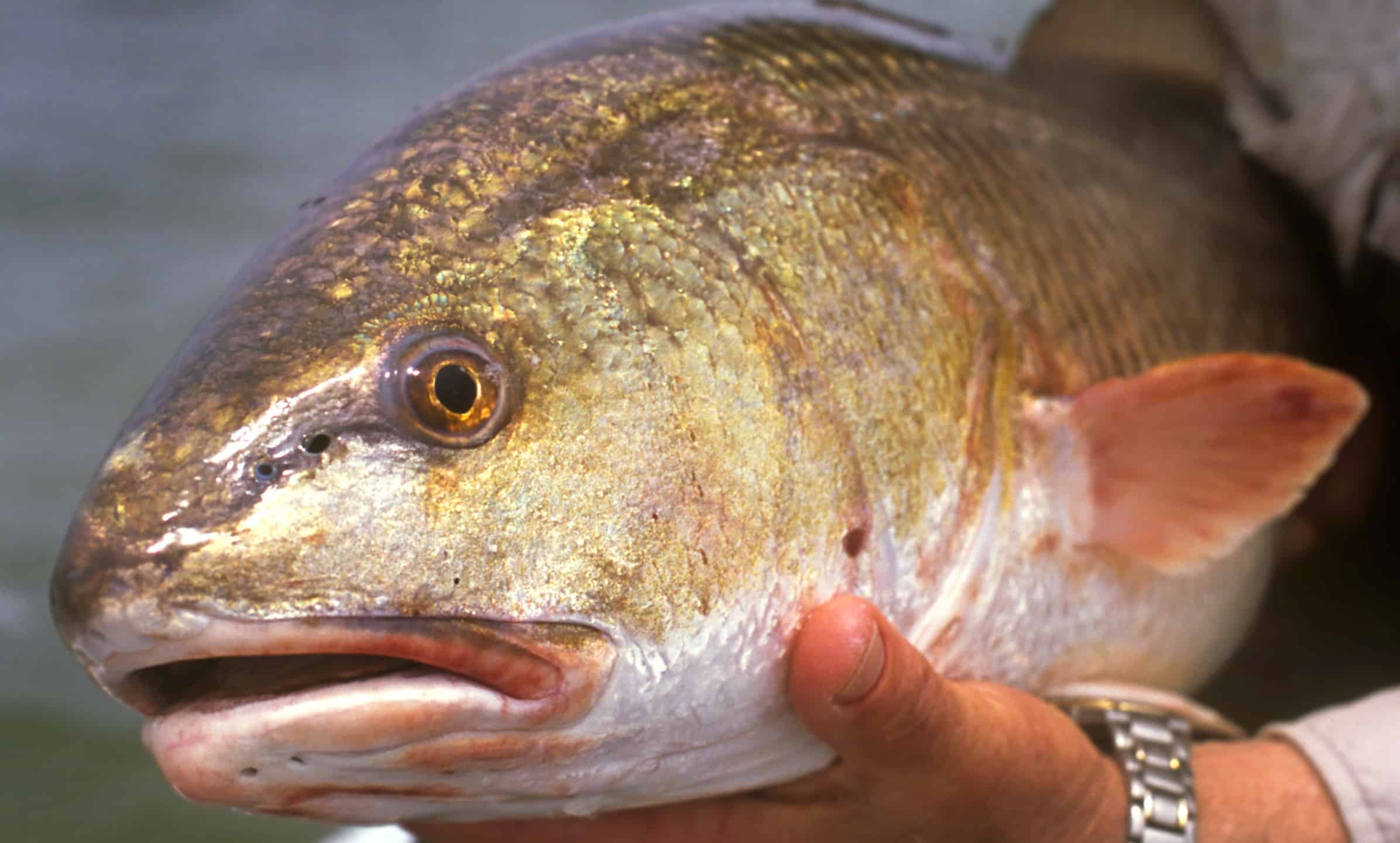
Red drum can weigh as much as 94 pounds.
©iStock.com/SteveClever
7. King Mackerel
King mackerel (Scomberomorus cavalla), also known as kingfish, are the largest species of mackerel in the Atlantic. They are iron-gray on top with silver sides and bellies. King mackerel can live in water that is 115 to nearly 600 feet deep. They are usually caught by trolling.
The average king mackerel weighs about 11-30 pounds, but these prize fish have been known to grow up to 100 pounds and 5.5 feet long.
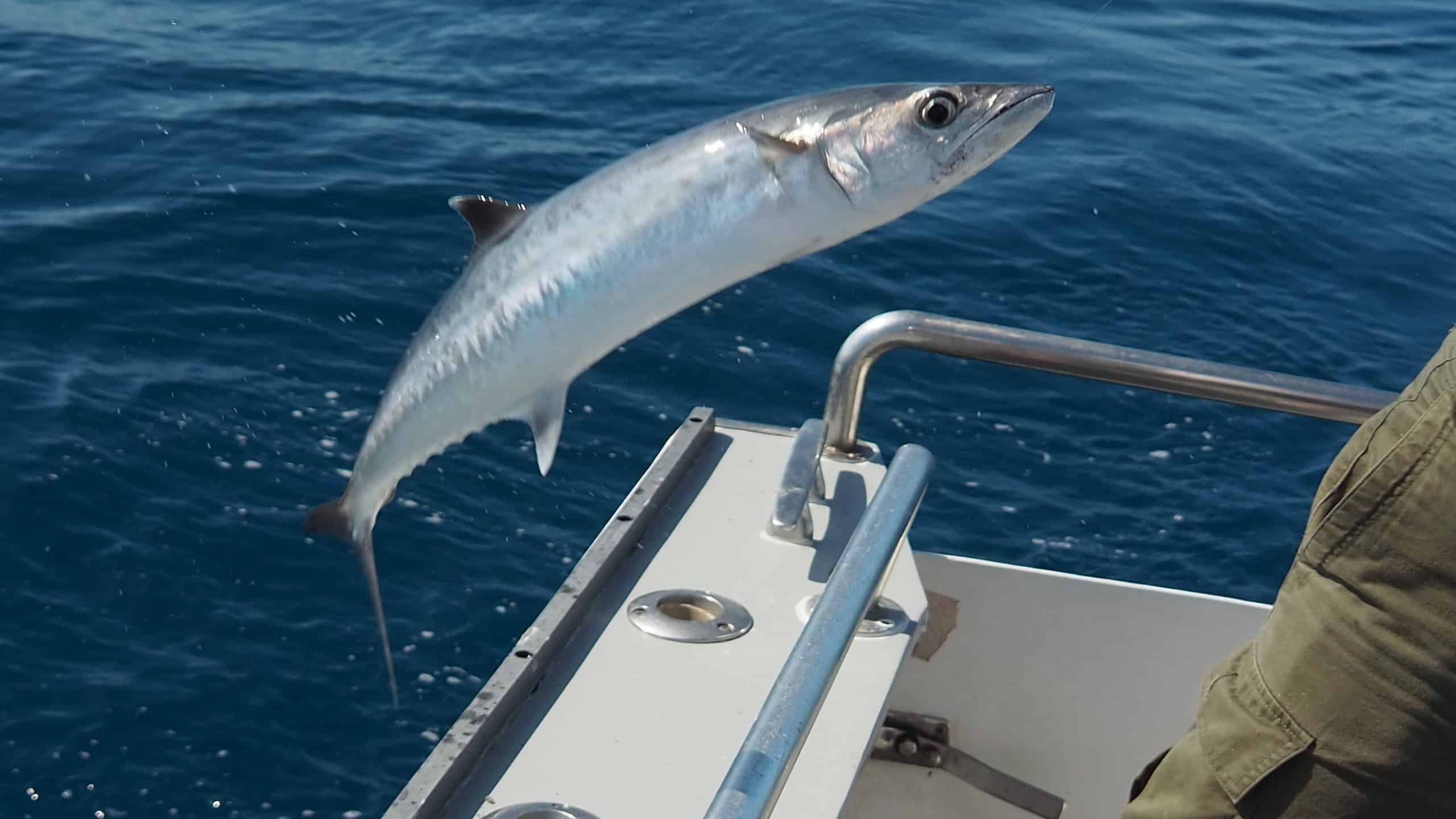
King mackerel are mostly gray and silver.
©Coastal Girl/Shutterstock.com
6. Cobia
Cobia (Rachycentron canadum) are a fascinating species sometimes mistaken for sharks or remoras (suckerfish). In fact, the cobia’s closest living relative is the remora, writes NOAA.
Cobia are dark brown in color and can grow quite large — sometimes up to six feet long and 100 pounds. They are popular for sight fishing, as cobia are easy to see when they swim near the surface. The record cobia was caught off Shark Bay in Australia and weighed 135 pounds, 9 ounces.
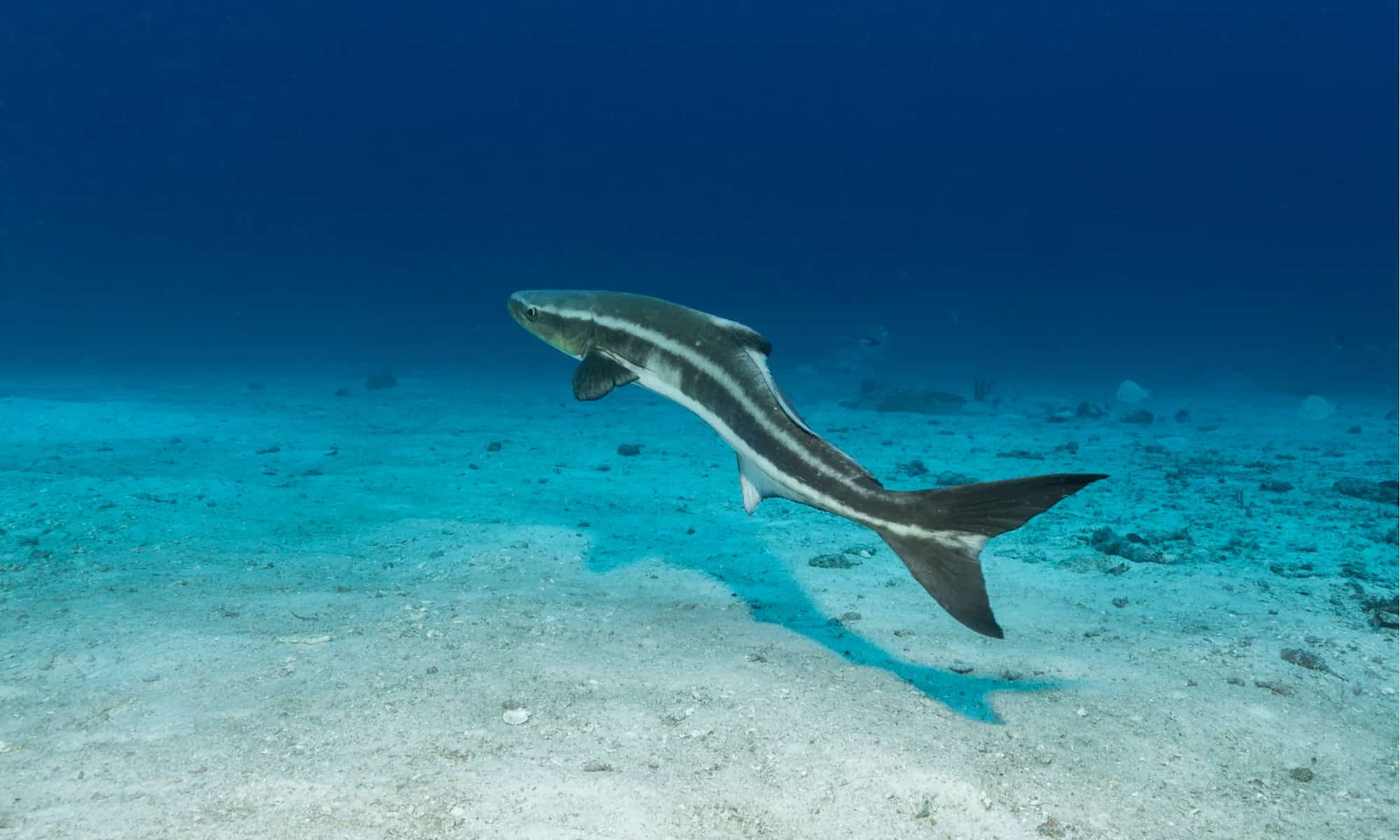
A Cobia is a sleek fish with a torpedo-shaped body.
©kaschibo/Shutterstock.com
5. Atlantic Wahoo
Wahoo (Acanthocybium solandri) are some of the fastest-swimming fish in the sea, with elongated blue bodies and an irregular pattern of vertical blue bars. Wahoo’s speed makes them a challenging catch and popular game fish. In the Gulf of Mexico, wahoo can even be successfully fished during the winter.
Atlantic wahoo are commonly 3.3-5.4 feet long and weigh between 15-40 pounds on average. However, much larger prize wahoo have been caught. The record, according to the IGFA, was a 184-pound monster caught in Cabo San Lucas, Mexico.
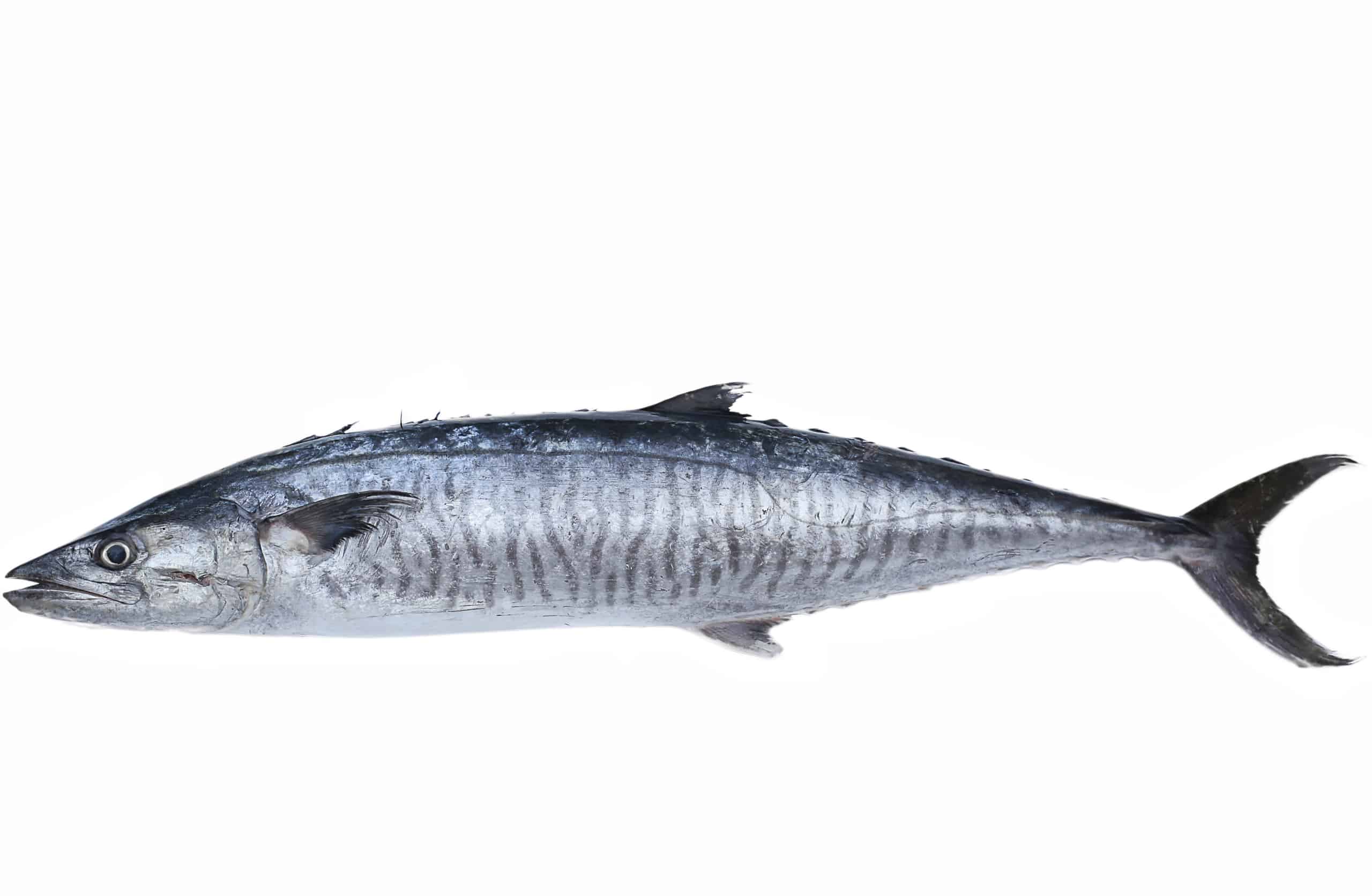
Wahoo fish are very fast, making them a challenging catch.
©Bignai/Shutterstock.com
4. Greater Amberjack
In the Gulf of Mexico, the stock of greater amberjack (Seriola dumerili) are currently overfished according to NOAA, so recreational fishing is subject to certain restrictions. This species has a brown or blueish-gray back, a white belly, and a dark amber stripe on its head.
Greater amberjacks are around 30-50 inches and 40 pounds on average, but adults can sometimes weigh up to 200 pounds and measure 6 feet long.
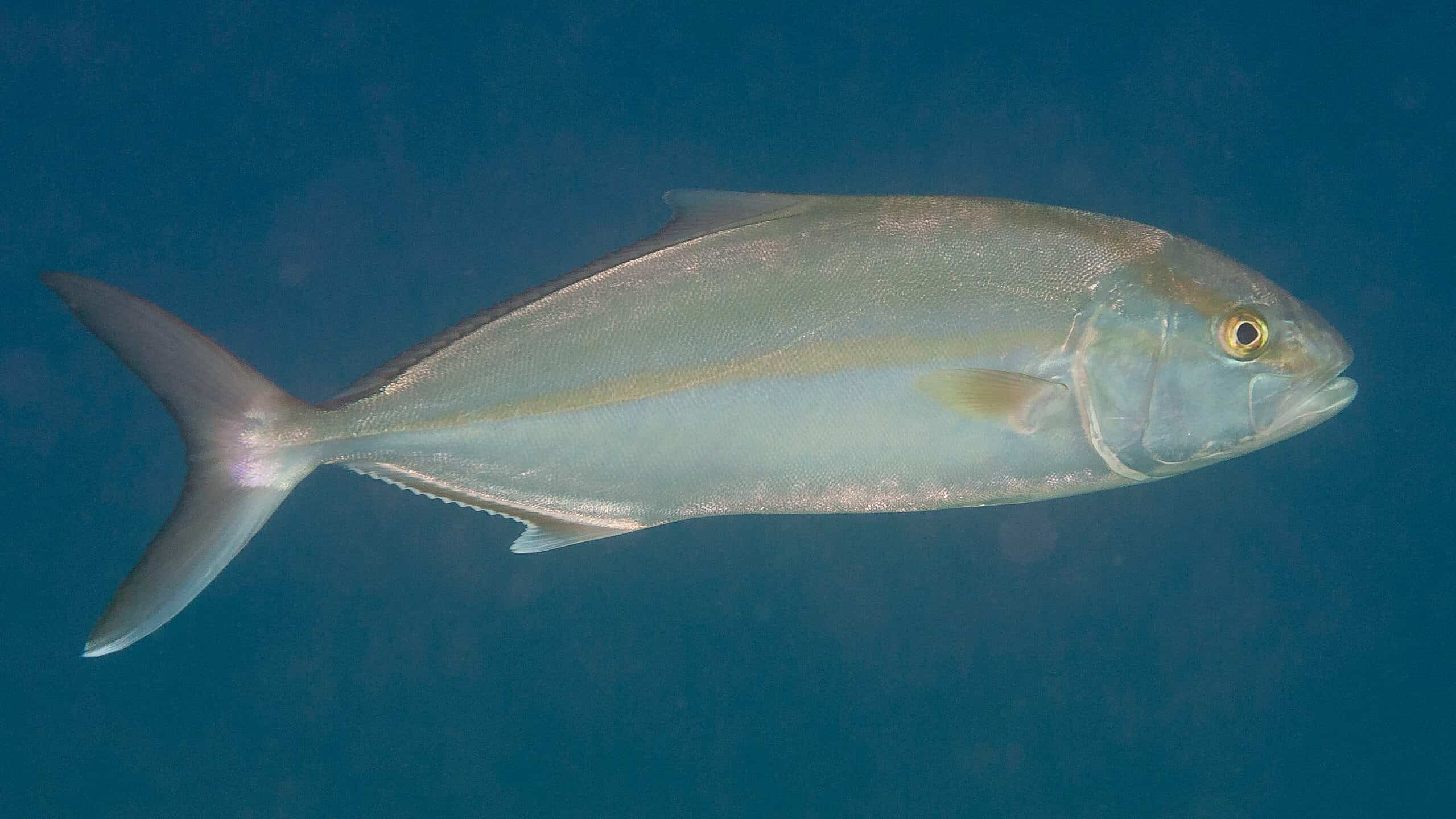
Greater amberjack have a dark amber stripe on their heads.
©Jesus Cobaleda/Shutterstock.com
3. Atlantic Tarpon
The Atlantic tarpon (Megalops atlanticus) is sometimes known as the “silver king.” These ray-finned creatures are highly valued game fish, revered for their size and strength, reaching a maximum recorded weight of 355 pounds and length of 8 feet, 2 inches.
Tarpon fishing is generally catch and release since their meat is considered undesirable. Killing a tarpon in certain states also requires a special permit. The tarpon is the official state saltwater fish of Alabama.
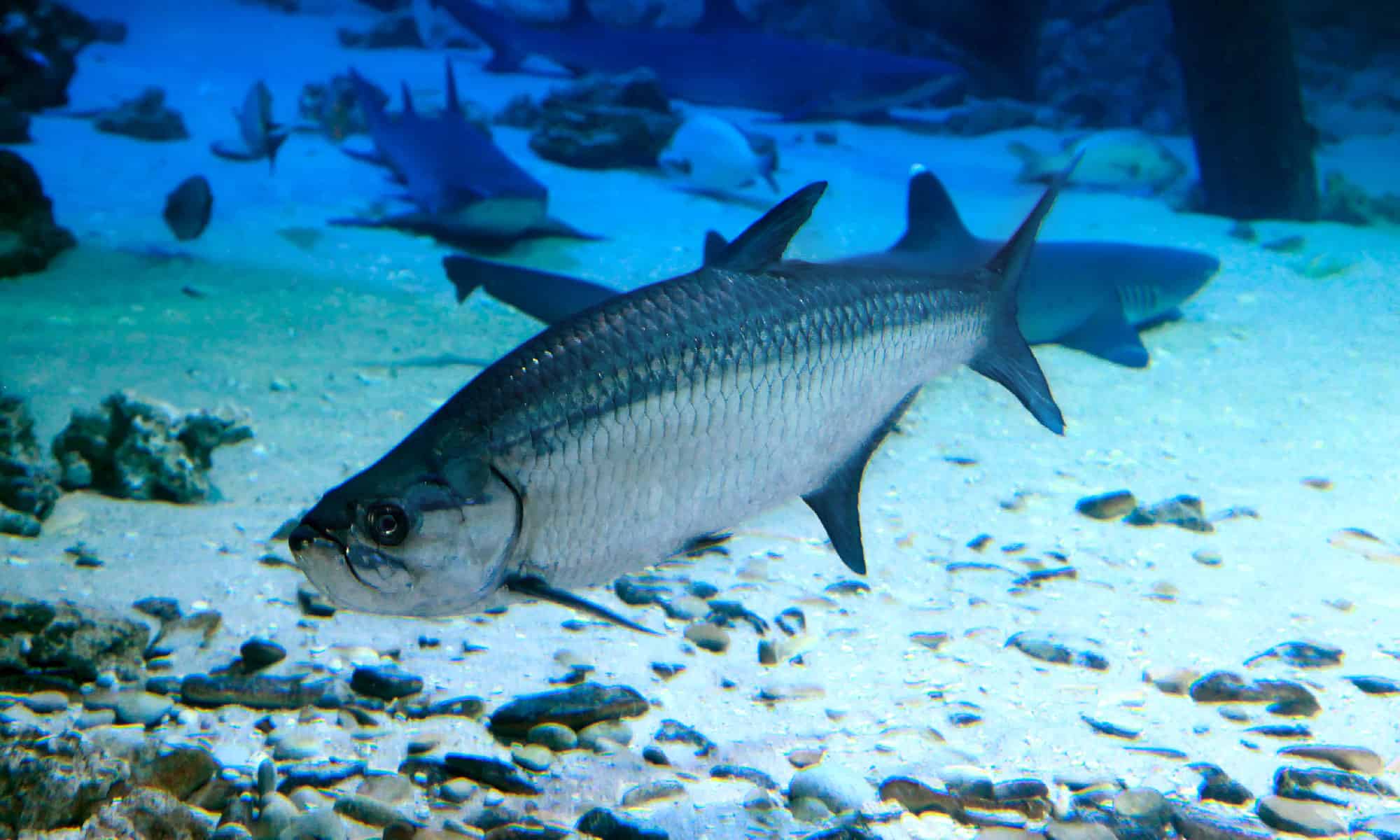
The Atlantic tarpon earned the nickname “silver king.”
©iStock.com/TatianaMironenko
2. Atlantic Yellowfin Tuna
Atlantic yellowfin tuna (Thunnus albacares) are a beautiful catch and a popular seafood choice. They are torpedo-shaped fish with a dark blue back and upper sides, bright yellow dorsal fins, and a yellow stripe down their side.
The average Atlantic yellowfin tuna reaches lengths of 32-43 inches and weighs 40-60 pounds. However, these quickly-growing fish can weigh up to 400 pounds and measure lengths of around 6 feet.
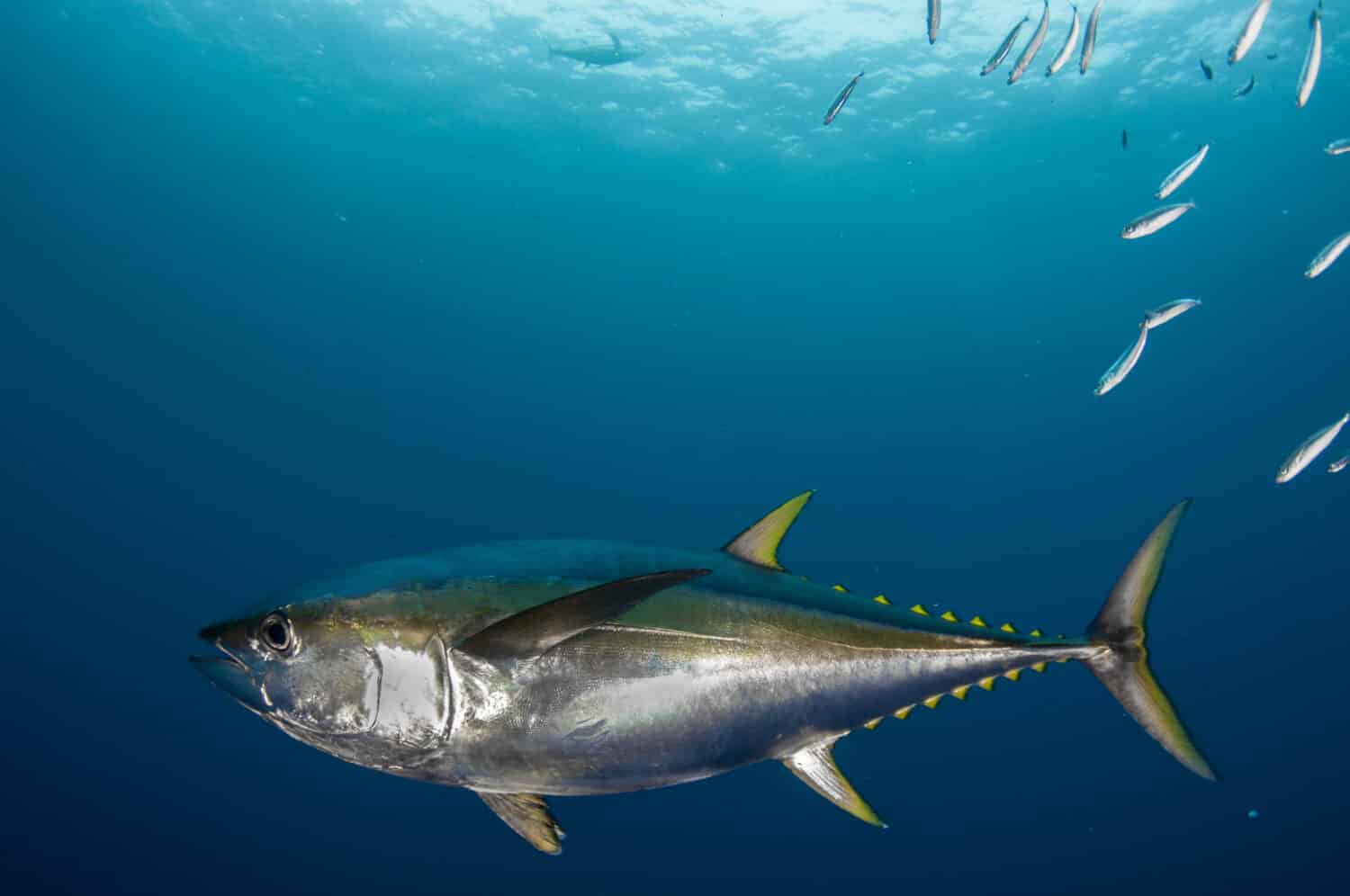
Yellowfin tuna are recognizable by the bright yellow stripe down their side.
©Shane Gross/Shutterstock.com
1. Atlantic Blue Marlin
As its name suggests, the Atlantic blue marlin (Makaira nigricans) is a species endemic to the Atlantic Ocean. These beautiful saltwater fish are a prize for any angler, but catching one isn’t for the faint of heart. Average-sized Atlantic blue marlin reach lengths of 11 feet and weigh between 200-400 pounds.
However, these creatures can exceed 1,000 pounds (known as “granders”) in weight and reach lengths of 14 feet. Interestingly, the biggest female Atlantic blue marlin is more than four times as heavy as the largest male.
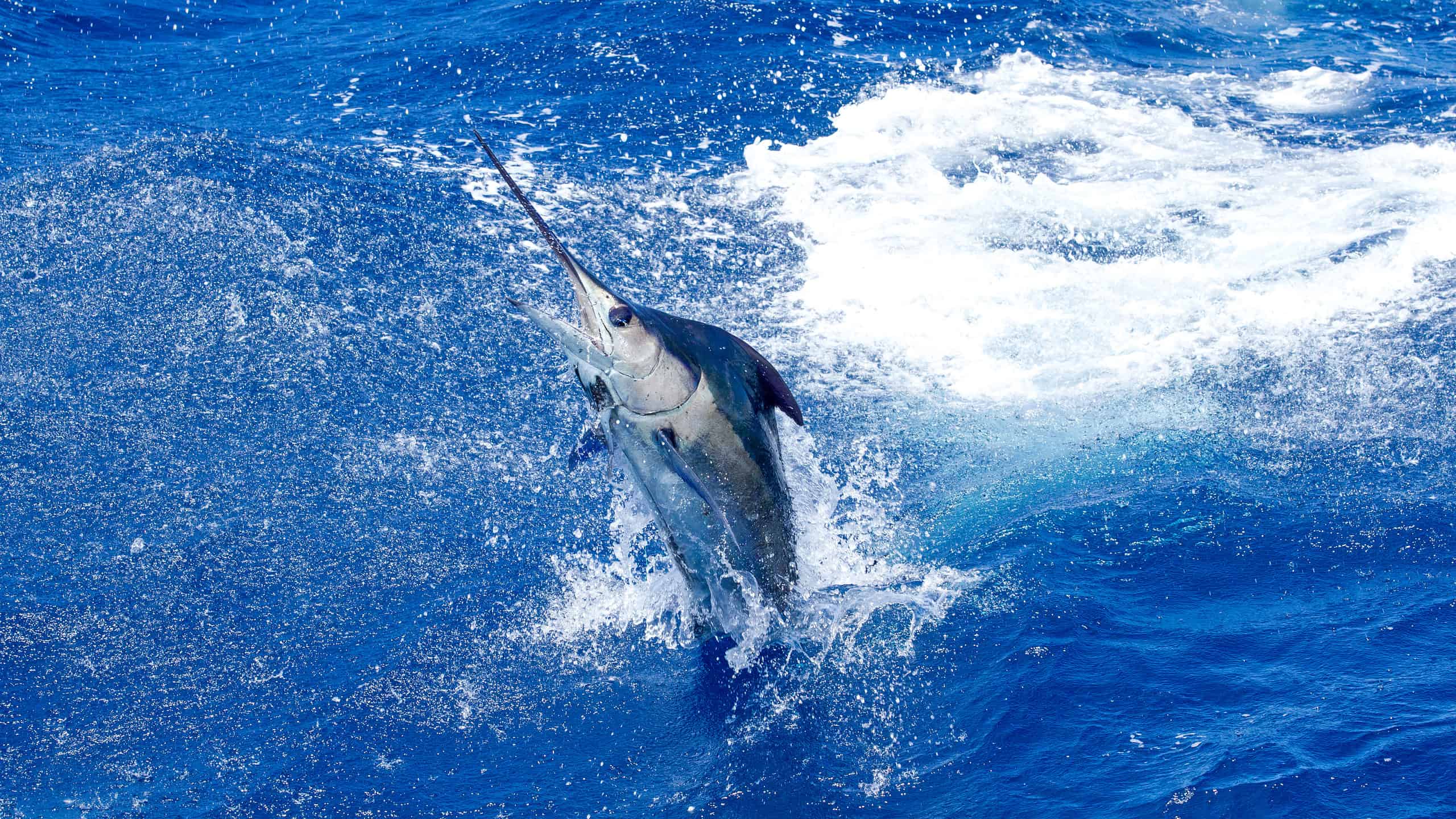
Blue Marlin can weigh over 1,000 pounds.
©kelldallfall/Shutterstock.com
Gulf of Mexico Trophy Fish Summary:
| Fish Species | Average Weight | Average Length | Max Weight | Max Length |
|---|---|---|---|---|
| Gulf Flounder | 1-5 pounds | 6-10 inches | 7 pounds, 2 ounces | 12-14 inches |
| Florida Pompano | 1-3 pounds | 12-16 inches | 8 pounds, 4 ounces | 23-25 inches |
| Black Sea Bass | 1.5-3 pounds | 12 inches | 10 pounds, 4 ounces | 24 inches |
| Spotted Sea Trout | 2-3 pounds | 15-25 inches | 17 pounds, 7 ounces | 39 inches |
| Sheepshead | 3-4 pounds | 13 inches | 21 pounds, 4 ounces | 36 inches |
| Bluefish | 3-5 pounds | 7-24 inches | 31 pounds | 39 inches |
| Red Snapper | 2-4 pounds | 1-2 feet | 50 pounds, 4 ounces | 40 inches |
| Red Grouper | 5-10 pounds | under 2 feet | 51 pounds | 49 inches |
| Crevalle Jack | 3-5 pounds | 1-2 feet | 57 pounds | 4 feet |
| Mahi-Mahi | 15-30 pounds | 2.8-4.6 feet | 87 pounds | 7 feet |
| Red Drum | 40 pounds | 40 inches | 94 pounds, 2 ounces | 4.1 feet |
| King Mackerel | 11-30 pounds | 30-45 inches | 100 pounds | 5.5 feet |
| Cobia | 30 pounds | 3-4 feet | 135 pounds, 9 ounces | 6.5 feet |
| Atlantic Wahoo | 15-40 pounds | 3.3-5.4 feet | 184 pounds | 8 feet |
| Greater Amberjack | 40 pounds | 30-50 inches | 200 pounds | 6 feet |
| Atlantic Tarpon | 60-280 pounds | 4-8 feet | 355 pounds | 8 feet, 2 inches |
| Atlantic Yellowfin Tuna | 40-60 pounds | 32-43 inches | 400 pounds | 6 feet |
| Atlantic Blue Marlin | 200-400 pounds | 11 feet | 1,402 pounds, 2 ounces | 14 feet |
The photo featured at the top of this post is © iStock.com/dombrowski
Thank you for reading! Have some feedback for us? Contact the AZ Animals editorial team.



